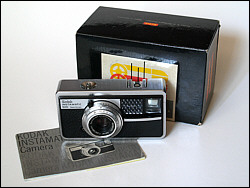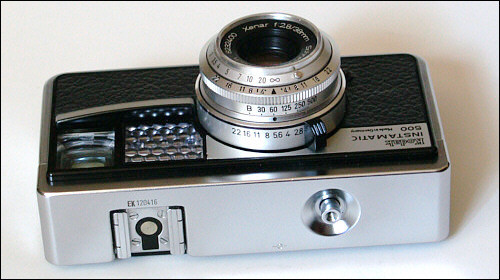Kodak Instamatic 500

|
|
|
| Style, film format | Fixed-lens camera taking 126 Kodak Instamatic cartridge film |
|
|
|
| Lens, shutter | Collapsible coated f/.28 38mm Schneider-Kreuznach Xenar lens in a Compur shutter with a coupled selenium meter |
|
|
|
| Photo quality | To come |
|
|
|
| Ergonomics | Very good. |
|
|
|
Every once in a while, you'll come across a great classic camera that seems to go unnoticed. This is one of them.
This was made in Kodak's factory in Stuttgart, although by this time, the operation had long ago shed the Nagel name. The camera's nameplate says simply, "Made in Germany."
Note that Kodak produced two German-made 126 cameras at this time: the Instamatic 500 and the Instamatic Reflex Camera (it actually says "Camera" on the front, so as not to confuse it with a blender or the lawn mower, I suppose).
The Instamatic 500, which was produced from 1963 to 1966, has a number of advanced features for what was decidedly a genre aimed at amateurs. In addition to the Schneider-Kreuznach Xenar lens and Compur shutter, it also has a Gossen meter (as did most Kodak Retinas with built-in meters), a metal body and a van Albada viewfinder with parallax lines included.
Operation of the camera is straightforward, and the camera's meter automatically adjusts itself for the correct film speed. With no film loaded, the meter defaults to ASA800. There is no way to manually set the film speed.
The viewfinder contains no information, just the frame lines. Beneath the viewfinder is the meter needle, which shows "-1" and "1+" with two notches in the center to indicate correct exposure in 1/2 stop increments. The needle bounces a bit, although it appears to still be accurate.
Like most Instamatics, the lever is a very short throw -- roughly 90 degrees -- to advance the film to the next frame.
A button on the bottom of the camera releases the lens. You must depress the button to collapse the lens, and you cannot take a photo unless the lens is extended.

Simple and straightforward controls ... very
German.
There is no rangefinder, so you must guess the distance to your subject. Alternatively, there are three symbols beneath the lens if you want to simply get it "close enough." The range of shutter speeds is limited to 1/30-1/500 plus B. There are no slow speeds. The shutter is very quiet indoors and would be imperceptible outdoors. I would say that it's even quieter than a Retina IIIS or Retina IIc/IIIc.
You have a full range of stepless apertures at your disposal, from f/2.8 to f/22.
The camera has a metal body with an attractive powder-chrome finish set off with a black leatherette covering that is very similar to the later Retina cameras. I wouldn't be surprised if it's the same material, as that would make the most sense from an economic and production standpoint.
It also has a real hot shoe, a flash synchronization post and a 35mm-style shutter release with the ability to take a threaded cable release.
The quality of construction is excellent, and I would rate this just behind the Rolleiflex SL 26 as being among the best of the 126 cameras.
